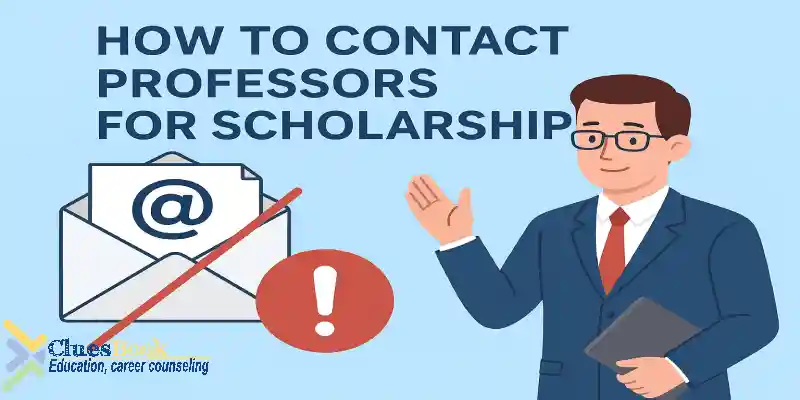Want to know the secret to getting a professor’s reply? Learn how to contact professors for scholarships the right way, with insider tips, powerful email examples, and strategies that actually work to land your dream opportunity.

Avoid These Common Mistakes When Emailing Professors for Scholarships!
Many students write to professors with great enthusiasm and good intentions, hoping for a positive response regarding scholarships or research positions. However, a few common mistakes often ruin their chances before the professor even finishes reading the email.
The result? The email gets deleted without being read or ignored completely.
If you want your email to impress the professor and actually get a reply, avoid these mistakes at all costs 👇
1️⃣ Sending the Same Email to Multiple Professors
Copy-paste or generic (template-style) emails are instantly recognizable. Professors receive dozens of such messages daily and can easily tell when an email isn’t personalized.
✅ Solution: Personalize every email. Mention the professor’s name, their research area, and one of their specific publications or projects that you found interesting.
This shows genuine interest and effort on your part.
| Follow us on Facebook for more interesting content |
2️⃣ Using a Vague or Unprofessional Subject Line
Subject lines like “Hello” or “Need Scholarship” make your email look unprofessional and easy to ignore.
✅ Solution: Write a clear, concise, and relevant subject line. For example:
“Inquiry About Research Opportunities in Energy Materials”
3️⃣ Writing an Overly Long Email
Professors are busy. Emails that go on for two or three pages are rarely read completely.
✅ Solution: Keep your email within 200–300 words.
Structure it as:
Introduction: Briefly introduce yourself.
Body: Mention your research interests and why you want to work with them.
Closing: Politely thank them and mention your attached CV.
4️⃣ Using Informal or Grammatically Incorrect Language
Phrases like “Respected Sir plz give me letter” or poorly written sentences leave a bad impression.
✅ Solution: Use polite, grammatically correct, and professional language.
Example:
“Dear Professor [Name], I am writing to inquire about your research on [Topic]…”
5️⃣ Directly Asking for an Acceptance Letter
Requesting an “acceptance letter” in the very first email sounds desperate and inappropriate.
✅ Solution: Show interest first, then seek guidance.
Example:
“I am highly interested in your research group. Could you please guide me regarding possible openings or research directions?”
| Must Prepare for Interview with Powerful Scholarship Interview Tips |
6️⃣ Not Mentioning Your Academic Background
Some students just write, “I want to study under you,” without any background details.
✅ Solution: Briefly introduce your academic qualifications and research interests.
Example:
“I hold a BS in Physics and my research interests align with your work on nanomaterials.”
7️⃣ Attaching Irrelevant or Heavy Files
Some attach too many or unnecessary documents, while others forget to attach a CV at all.
✅ Solution: Attach only your updated CV, and mention it in the email.
Example:
“My updated CV is attached for your kind consideration.”
8️⃣ Misspelling the Professor’s Name or Title
Mistakes like “Dear Smoth” or just “Dear Sir” can instantly turn off a professor.
✅ Solution: Always double-check the spelling of the professor’s name and title (Prof./Dr.), and address them respectfully.
9️⃣ Showing Too Much Confidence or Desperation
Statements like “I am the best candidate for your lab” or “Sir please please reply” can sound either arrogant or needy.
✅ Solution: Maintain a balanced, confident, yet humble tone.
Example:
“I believe my research background aligns well with your current projects.”
🔟 Sending Too Many Follow-Up Emails
Sending repeated emails every day or even every few days can annoy the professor.
✅ Solution: Wait 7–10 days before sending a polite reminder email.
1️⃣1️⃣ Not Proofreading Before Sending
Many students send emails in a hurry, full of typos, missing attachments, or unclear sentences.
✅ Solution: Always proofread your email before sending.
You can also ask a friend or mentor to review it once.
| If you are an international student must apply for fully funded M.Phil scholarships |
1️⃣2️⃣ Emailing at Irregular or Inappropriate Times
Sending emails at midnight or on weekends might cause your message to get buried under others.
✅ Solution: Try to send your email during working hours (daytime) when professors are more likely to check their inbox.
List of Peking University School of Life Sciences Professors
✳️ Summary on How to Contact Professors for Scholarships
A successful email to a professor should be:
🔹 Concise: Avoid unnecessary details.
🔹 Clear: State your purpose directly.
🔹 Polite: Use professional and respectful language.
🔹 Relevant: Show how your interests align with their research.
If you follow these principles, your email will stand out, and your chances of receiving a positive response will increase dramatically.
| Must apply for Fully Funded Scholarships in USA |
💬 Your Turn:
Have you ever received a reply from a professor?
Share your experience in the comments so other students can learn too!
📢 If you found this guide helpful, don’t forget to share it with others.
For more updates on scholarships, research tips, and career guidance, follow me!
#ScholarshipGuide #EmailTips #StudyAbroad #PhDScholarship #MastersAbroad #StudentsLife #ResearchOpportunities #EducationMatters #MotivationForStudents
